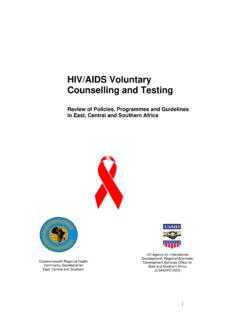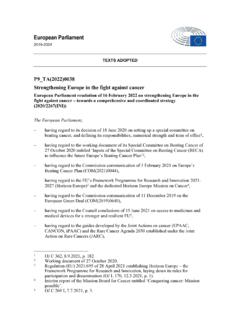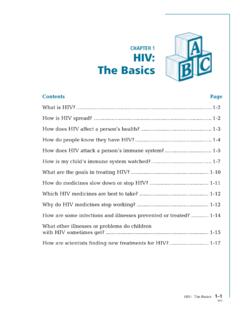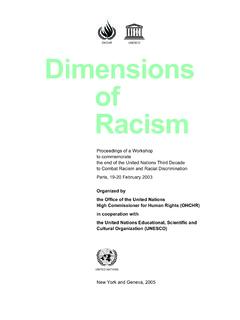Transcription of Overview of HIV Infection - World Health Organization
1 Module 1: Overview of HIV Infection 1 Participant Manual 2005 Module 1 Overview of HIV Infection Purpose To provide you with the basic terms and concepts related to HIV Infection . Pre-requisite Modules None Learning Objectives At the end of this module, you will be able to: Describe the difference between HIV Infection and aids Discuss the HIV epidemics globally, regionally, and locally in terms of number of people affected Define the terms: antibody and antigen Explain how window period may affect HIV testing results Describe the progression of HIV Infection Content Outline What is HIV? What is aids ?
2 The HIV pandemic HIV transmission Window period Stages of HIV Infection Handout WHO Staging System for HIV Infection and Disease in Adults and Adolescents Notes on Customization Provide local HIV Infection rate and its impact on local community. Module 1: Overview of HIV Infection 2 Participant Manual 2005 What is HIV? Many people see HIV and aids as being the same thing, and therefore make the assumption that someone who is HIV-positive could die tomorrow. This is not true. It is important to distinguish between HIV and aids . HIV stands for Human Immunodeficiency Virus. Human: Infecting human beings Immunodeficiency: Decrease or weakness in the body s ability to fight off infections and illnesses Virus: A pathogen having the ability to replicate only inside a living cell Types of HIV Virus There are two types of HIV virus: HIV 1 is most common in sub-Saharan Africa and throughout the World .
3 HIV 1 can be divided into groups M, N, and O. The pandemic is dominated by Group M, which is composed of subtypes A J. HIV 2 is most often found in West Central Africa, parts of Europe and India. Both produce the same patterns of illness. HIV 2 causes a slower progression of disease than HIV 1. It is important for tests to detect the HIV subtypes that are present in the region. Otherwise, testing may lead to false negative results. Structure of HIV Like all viruses, HIV virus is made up of 2 main elements: the external envelope, and the internal core. ` HIV is in a family of viruses called retrovirus. Specific test methods are used to detect and measure certain parts of the virus.
4 For example, a test to detect the core of the virus called p24 is used to detect early or pediatric infections. Core p24 RNA Reverse Transcriptase Envelope Module 1: Overview of HIV Infection 3 Participant Manual 2005 What is aids ? aids stands for: Acquired: To come into possession of something new Immune Deficiency: Decrease or weakness in the body s ability to fight off infections and illnesses Syndrome: A group of signs and symptoms that occur together and characterize a particular abnormality aids is the final stage of the disease caused by Infection with the virus. HIV vs. aids HIV is the virus that causes aids .
5 Not everyone who is infected with HIV has aids . Everyone with aids is infected with HIV. aids is the result of progression of HIV Infection . Anyone infected with HIV, although healthy, can still transmit the virus to another person. HIV Infection leads to a weakened immune system. This makes a person with HIV vulnerable to infections. aids results when HIV Infection progresses to an advanced stage, damaging the immune system to a point at which the body can no longer fight illness. Drugs are available which can treat HIV and aids . These drugs are called antiretrovirals (ARVs). They prevent the virus from replicating and slow the progress of the disease.
6 Currently, there is still no cure for aids or a vaccine that will prevent HIV Infection . Information Box How HIV weakens the immune system Our blood contains white and red blood cells. Normally the white cells fight off and kill any germs which enter our bodies. They do this by eating up the germs and by producing chemicals called antibodies which kill them. In this way our bodies fight off many different germs and we stay healthy. Sometimes we have symptoms of illness when our white cells are fighting the germs, but usually the white cells win and we get better. HIV weakens the immune system by entering and destroying our white cells.
7 As more and more white cells are killed, the body becomes less and less able to fight off the many different germs which live around and in our bodies all the time. After many years the white cells are so damaged that these germs, which normally do not cause problems, can cause deadly diseases. Module 1: Overview of HIV Infection 4 Participant Manual 2005 How is HIV Transmitted? HIV is transmitted through: Unprotected sexual contact with an infected partner Exposure of broken skin or wound to infected blood or body fluids Transfusion with HIV-infected blood Injection with contaminated objects Mother to child during pregnancy, birth or breastfeeding HIV: A Global Pandemic The above graphic provides estimates for the numbers of persons living with HIV in different continents in 2003.
8 Between 34 and 46 million persons live with HIV; most of these in Africa. HIV Infection is a worldwide epidemic a pandemic affecting people everywhere. Adults and children estimated to be living with HIV/ aids (2003): 34 46 million total Western Europe 520 000 680 000 North Africa & Middle East 470 000 730 000 Sub-Saharan Africa million Eastern Europe & Central Asia million South & South-East Asia million Australia & New Zealand 12 000 18 000 North America 790 000 million Caribbean 350 000 590 000 Latin America million East Asia & Pacific 700 000 million Module 1: Overview of HIV Infection 5 Participant Manual 2005 HIV Epidemic in Sub-Saharan Africa Study the chart above and notice the growing number of people living with HIV and aids and the growing trend of HIV prevalence Testing for Viral Infection and Immune Response HIV Infection can be measured in terms of.
9 The amount of virus circulating in the body called the viral load The amount of antigen p24 antigen circulating in the body Proteins or cells that protect the body against Infection IgG and IgM antibodies, and CD4 cells Information Box Definition of antigen and antibody Antigen is a substance recognized as foreign by the immune system. Antigens can be part of an organism or virus, , envelope, core (p24) and triggers antibody production. Antibody is a protein (immunoglobulin) made by the body s immune system to recognize and attack foreign substances Module 1: Overview of HIV Infection 6 Participant Manual 2005 Information Box Measuring human response to HIV Infection : B and T cells T and B cells are types of white blood cells called lymphocytes that provide protection against Infection .
10 B cells are responsible for producing antibodies. There are three types of T cells. Helper T-Cells (also called CD4+ cells) help other cells destroy infective organisms. Suppressor T-Cells (also called CD8+ cells) suppress the activity of other lymphocytes so they don t destroy normal tissue. Killer T-Cells (also called cytotoxic T lymphocytes, or CTLs, and are another kind of or CD8+ cell) recognize and destroy abnormal or infected cells. Over a period of time, HIV infects and kills white blood cells called CD4 lymphocytes or (T cells), leaving the body unable to fight off certain kinds of infections. Evolution of Antibodies Study the chart above and notice the timeframe by which antibodies are produced.


















